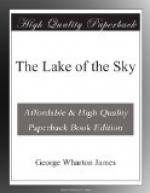Writers on this subject seem to regard glacial
erosion as mostly, if not wholly, a grinding
and scoring; the debris of this erosion
as rock-meal; the great bowlders, which are found
in such immense quantities in the terminal deposit,
as derived wholly from the crumbling cliffs above the
glacial surface; the rounded bowlders, which
are often the most numerous, as derived in precisely
the same way, only they have been engulfed by
crevasses, or between the sides of the glacier
and the bounding wall, and thus carried between the
moving ice and its rocky bed, as between the upper
and nether millstone. In a word, all bowlders,
whether angular or rounded, are supposed to owe
their origin or separation and shaping
to glacial agency.
Now, if such be the true view of glacial erosion, evidently its effect in mountain sculpture must be small indeed. Roches moutonnees are recognized by all as the most universal and characteristic sign of a glacial bed. Sometimes these beds are only imperfect moutonnees, i.e., they are composed of broken angular surface with only the points and edges planed off. Now, moutonnees surfaces always, and especially angular surfaces with only points and edges beveled, show that the erosion by grinding has been only very superficial. They show that if the usual view of glacial erosion be correct, the great canyons, so far from being formed, were only very slightly modified by glacial agency. But I am quite satisfied from my own observations, that this is not the only nor the principal mode of glacial erosion. I am convinced that a glacier, by its enormous pressure and resistless onward movement, is constantly breaking off large blocks from its bed and bounding walls. Its erosion is not only a grinding and scoring, but also a crushing and breaking. It makes by its erosion not only rock-meal, but also large rock-chips. Thus, a glacier is constantly breaking off blocks and making angular surfaces, and then grinding off the angles both of the fragments and the bed, and thus forming rounded bowlders and moutonnees surfaces. Its erosion is a constant process of alternate rough hewing and planing. If the rock be full of fissures, and the glacier deep and heavy, the rough hewing so predominates that the plane has only time to touch the corners a little before the rock is again broken and new angles formed. This is the case high up on the canyon walls, at the head of Cascade Lake and Emerald Bay, but also in the canyon beds wherever the slate is approached. If, on the other hand, the rock is very hard and solid, and the glacier be not very deep and heavy, the planing will predominate over the rough hewing, and a smooth, gentle billowy surface is the result. This is the case in the hard granite forming the beds of all the canyons high up, but especially high up the canyon of Fallen Leaf Lake (Glen Alpine




